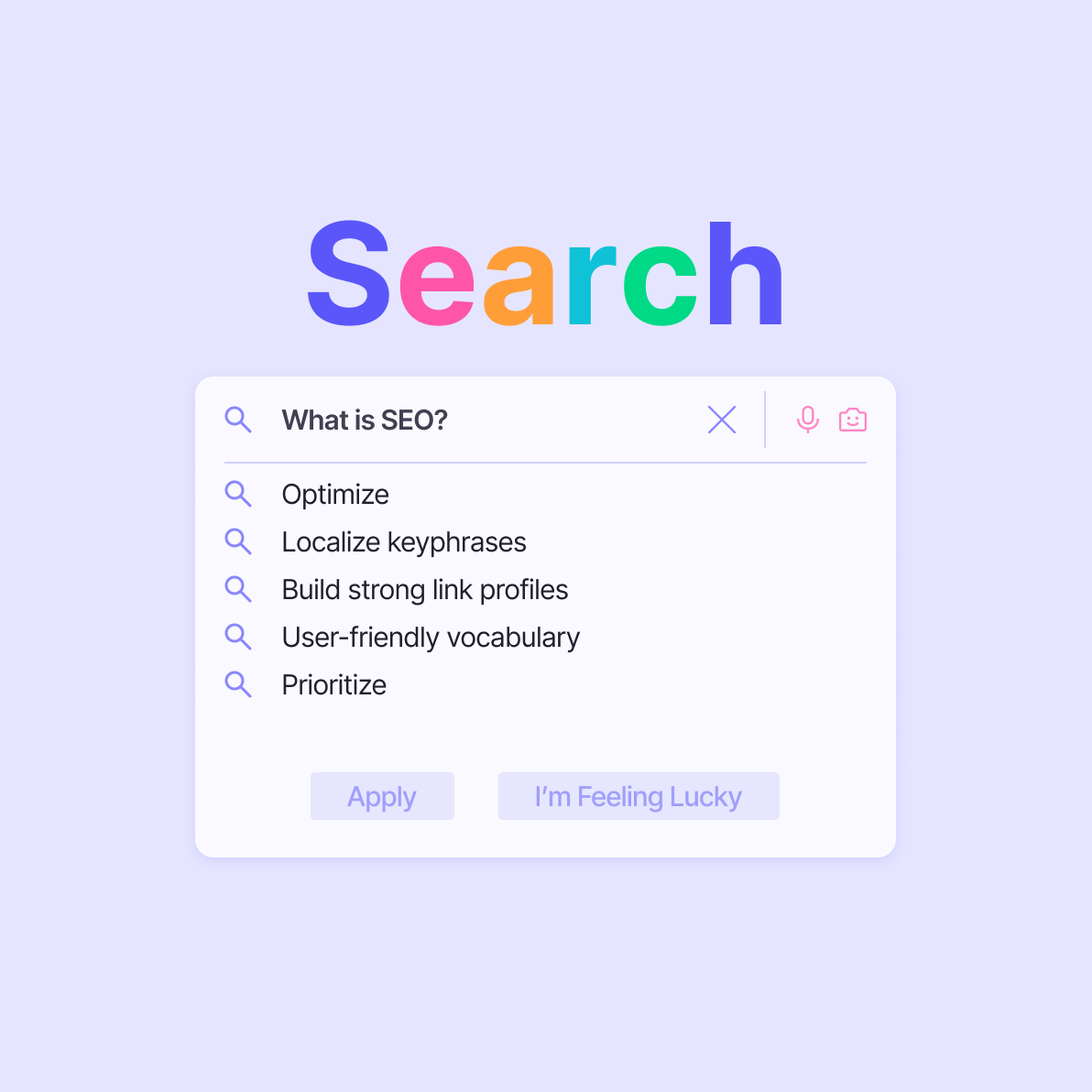We’re going to be real frank with you—SEO is hard. It’s not some fool-proof scheme where you can just plug in a crapload of keywords and end up on the first page of Google. If it were that easy, you wouldn’t be reading this blog now, would you?
If you don’t know, SEO stands for Search Engine Optimization, three words that everyone thinks about, but very few know what they mean (or how the hell SEO works).
Even for professional SEOs, like our team at Lifted Logic, implementing effective SEO can be difficult.
As a digital agency in Kansas City, we’ve spent years studying SEO and all things web (we even build unique, SEO-driven websites that actually drive traffic), but things are always changing (except core practices, of course). Seriously, we can’t catch a break here. Still, we work hard to stay on top of the curve so we can execute well-planned digital strategies for our clients that reap long-lasting benefits for their business—and their ROI.
If you’re wondering about SEO and how you can use it the right way for your business, keep reading for our ultimate 2021 guide on search engine optimization. In this guide, we’ll go over:
- What is SEO and how it works
- Domain Authority
- How to properly use backlinking
- The importance of keywords and quality content
- What to do when you think your SEO is “done”
How does SEO work?
We’re not going to get super technical here because honestly, the technicalities are boring and won’t help you really understand anything. What we will do is give you the pertinent information you need to know to get started without falling asleep while you read.
What is SEO?
To keep it simple, search engine optimization is a way to increase your web traffic through organic search results.
Based on that definition, there is one clear goal: increasing web traffic.
But wait. Don’t stop here and simply focus all of your attention on the quantity of your website traffic. You could have all the traffic in the world, but if it’s not the right traffic, then what’s the point?
Hint: there isn’t one.
Example time. Say you own a vegan pizza shop and you’re trying to get more people to find your website. We’re going to be real honest here: there are some people who straight up hate the idea of cashew “cheese” pizza and wouldn’t go within a five mile radius of anything even close to it. So if you strategize an SEO plan that solely prioritizes quantity of users, you may end up with a lot of traffic, but it will probably include some of those very people who love cheese—and who will bounce from your website at the first hint of a substitute. That’s low-quality traffic you don’t want.
The point of a well-planned SEO strategy is to not only increase traffic, but to increase the quality of your traffic. You want to effectively target people who are interested in your products or services, and exclude people who are not—because this is what converts traffic to leads and leads to sales.
How do search engines work?
You can’t understand SEO without knowing a little about search engines work. After all, it’s literally called search engine optimization
While you’re working to optimize for search engines, search engines are determining if your content is relevant for a user. After all, Google, Bing, and Yahoo are businesses. At the end of the day, if they are not serving the right results to their consumers, they’ll stop getting traffic. And when they stop getting traffic, they don’t have the leverage they need to sell ad space. #FullCircle
Search engines log millions of pages of content every day using three main steps:
- Crawling
- Indexing
- Ranking
Bots, often called spiders, crawl through the web to find new content, including text, videos, pdfs, images—you name it. The primary method for these spiders to discover new content is via hyperlinks.
Once the bots find a new URL that hosts some form of content, they index it. That means they save it into a massive online database that their users will then be able to search through.
In general, this crawl process can take anywhere from 2 to 6 weeks to recognize new content on the web.
Then here comes our oh-so-important friend, ranking. Ranking is the order in which content from various sources appears on a SERP. It’s the question ever SEO spends their days researching and practicing, but one whose answer is ever-evolving.
How do I rank for a keyword in 2021?
Here are the cold, hard facts: 75% of people never scroll past the first search results page. So if your website doesn’t appear on the first page of results after typing in important keyphrases, your content may be hard to find organically.
Yeah, ouch.
Before you can focus on ranking, you’ll first want to make sure search engines are properly crawling and indexing your site.
How? Even if you don’t own a Google Webmasters account (the main dashboard you can use to communicate your website content to Google), it’s pretty simple to check. All you have to do is open Google, type “site:yourdomainname.com”, and see if pages pull up.
If you get back the fatal “0 Results”, here may be a few reasons why:
- Your website is brand spanking new.
- Other sites haven’t linked to your website (keep reading and we’ll give you some deets on backlinking).
- Your website navigation sucks so bad a bot can’t even get through it (hello, UX is that you?).
- Your site contains a crawler directives code that stops search engines from indexing pages (i.e. the robots.txt file).
- You tried to cheat the system, and now Google has penalized your site for it.
Once you’ve confirmed your site is pulling through in Google, it’s time to get to work.
How does Google determine rank?
There is a wide variety of factors that search engines use to determine the order of their results—and therefore the relevance of your website to a specific query. But before we get into those, there’s something we should clear up.
90% of SEO has nothing to do with your content, and everything to do with the quality of your website.
You can write thousands of words of search-engine-optimized content, but if your website is not considered trustworthy, your efforts won’t get you very far.
When evaluating the quality & trustworthiness of a website, search engines look at things like:
- Page Load Speed
- Mobile Usability
- User Behavior & Bounce Rate
- Structured Data & Metadata
- Quality of Code
- Quality of Grammar & Syntax
- Accessibility
- Outbound & Inbound Links
- Logical URL Structures
- & More
Many in the industry refer to this as “Domain Authority.”
How Domain Authority impacts SEO
I’m sorry… domain what?
Domain Authority is actually a proprietary metric created by an SEO software company called Moz, and it helps people determine how well their website will rank on certain SERPs.
Your Domain Authority lies between 1 and 100 (new websites start at 1); the higher your score, the better. To check your own Domain Authority, use Moz’s link explorer page to get started, then come back to our 2021 guide to search engine optimization. We’ve got more to tell you!
Now, if you find yourself with a lower score, don’t get discouraged! Web giants such as Google and Wikipedia are going to lean more toward the 90 to 100 range. Us regular, shmegular folks aren’t going to have that high of a Domain Authority (without working really really hard for years and years on search engine optimization and backlinking, anyway).
That’s why Domain Authority is meant to be used as a comparative measure. If your domain authority is 20, but your competitors only have a domain authority of 5, you’re probably going to rank better than them and pull more traffic to your site.
But here’s the good news: you can always work to improve your Domain Authority. And by “can”, we mean should.
You start by understanding how Domain Authority translates to Google and other search engines.
Specifically, Moz uses the idea that Google seeks out websites based on Expertise, Authoritativeness, and Trustworthiness (E.A.T.). That means you’re such an expert in your field that other websites agree, leading search engines to see you as trustworthy.
When you implement the best SEO practices of 2021, you truly become what you E.A.T. In other words, a well-rounded SEO strategy is key to increasing your Domain Authority and rank.
Let’s start delving into those SEO best practices to help your business go from stagnant to overflowing with growth.
Backlinking: How to do it the RIGHT way
First of all, if you’re currently buying links, for the love of all things good in this world—stop. And before you roll your eyes and say “we won’t stop, we’ll just proceed with more caution.” That’s a hard no. We’re serious. Don’t proceed at all… just stop.
Buying backlinks gets penalized because search engines want you to earn your links the good ol’ fashioned way—so like most things in the digital world, don’t try to cheat the system. You aren’t sneaky, guys. Search engines will find you, and they will kill you(r site).
Now that we’ve got that off our chest…What are backlinks?
Backlinks are a sort of digital referral that gives your site the “thumbs up.” Anytime another website (another domain) links to yours, that’s a backlink.
Basically, backlinks are key to helping search engines determine your expertise, authoritativeness, and trustworthiness. But you don’t want just any kind of backlinks. You want backlinks from quality sites that are also trustworthy.
Think about it this way. You want people to trust that your vegan pizza shop is a credible restaurant. So you pay Billy Jo $20 to pass around your business card and tell others they should visit your shop. That could’ve worked, except everyone knows Billy Jo is allergic to pizza, so they don’t trust him, and as a result they don’t trust your pizza shop.
The ideal situation: You start passing around your business card to pull people in. People visit, like your pizza, then pass your business card to others. These are credible people who aren’t sharing your card because they have to but because they want to. They truly believe in your product. And as this sharing process continues, your business card is everywhere, which makes your shop more prominent.
The same applies to backlinking. When you have a variety of credible websites linking to yours, you become more prominent because search engines tend to rank you higher. But keep in mind that building credible links takes time, which is why many people try to cheat their way out of it altogether.
Here are a few strategies you can use to build backlinks the right way:
Create a blog. Blogs are not only a great way to get more content out there, they are also huge linking opportunities. When you create relevant, high-quality blog content, more people will naturally want to use your site as a source for their own website. These editorial links don’t require extra work other than building up your blog.
Write about trustworthy business partners. If you have a business partner that has really helped your company grow, give them a shout out! You can easily write a blog post, then let them know what you wrote and suggest they write about it on their site. That would lead them to link to your story, and it’s a win-win for both parties. They get proof that they are a good company (plus a link) and you get a link to your website.
Pro tip: Stay away from excessive link exchanges. The idea of “I’ll scratch your back if you scratch mine” will trigger search engines after awhile.
Engage with the community. Community engagement is key for local businesses. When you engage with your community, you open the door for media outlets, bloggers, and other local businesses to highlight you on their websites. You can host events such as webinars, blood drives, and workshops or you can attend other people’s events. You can also offer free knowledge to these audiences! Offer to write an informative blog on a topic on which you are an authority. Tell them you will provide this content for their website or other marketing efforts for FREE in exchange for a link to your website.
Become active on social media. Many people ignore links from social media. They don’t have as much power as website links, but they can still help you with your SEO efforts. Plus, signing up is free, so definitely give it a go!
Put links everywhere. Put them in your email signature. Put them into your proposals. Put them in press releases. Hell, send them to news outlets. The more you can get the word out about your website and the resources within it, the better your chances of getting featured.
The main takeaway when it comes to backlinks and increasing domain authority? Treat links like business cards. Exchange them, feature them, and ask for them in return. Prioritize higher authority links (a CEO’s business card is worth more than an intern’s!) and don’t be afraid to reach out to your counterparts and other community leaders for help.
Creating keyword-optimized, quality content boosts SEO
Remember how we said 90% of SEO is the quality of your website? Well, the remaining 10% is content.
Think about it like this. Domain authority is your car. The engine, the tires, the body. All of the things we’ve just discussed above contribute to the overall power you have to get where you need to go on the web.
Content, then, is the driver of that car.
By writing high quality, informative content, you can effectively “steer” your car in the right direction.
Most people understand that content is important, but very few people know how to use it to their advantage.
We’ll start by telling you a little story:
Once upon a time—back when search engines were young and fresh—creating optimized content only involved keywords. Little Sally made major bucks just by finding neglected niches, creating microsites, throwing a bunch of keywords into the content, then leading traffic to a product she was selling. She was happy. She was successful. She was thriving.
But then the 2011 Google Panda update changed everything.
The new algorithm aimed to reduce the amount of thin, non-useful content that was swarming the internet. Google was tired of seeing the same three blogs recycled over and over again that did nothing to help answer user questions.
Little Sally could no longer depend on her overly optimized, low-quality content to help her rank. Instead, she had to write original, in-depth content that mattered to the user. So she did, and everyone lived happily ever after.
The end.
Moral of the story: some of the “hacks” or “tricks” that used to work for content and keywords in the past do not work in 2021. So how do you begin writing original in depth content that matters to the user? Well, first you have to understand what matters to the user. With keyword research, you can discover what a user is searching for, but you want to go beyond the what and look at the why. In other words, what is the user intent behind a query?
Do not ignore user intent
All too often people find a keyword, write based on that keyword, and then it falls flat. That’s typically because they didn’t consider user intent. As we said before, user intent is the why. Everyone searches for something for a reason. Think about user intent as someone asking Google a question. It’s now your job to provide the best answer.
What’s in a SERP?

One important key to understanding user intent is to think through the psychology of a user who lands on a search engine results page, or SERP. Here are a few of the main components of a SERP.
Ads
If you look at a search engine results page (SERP), you’ll typically first find a list of ads. on top then other listings below. Ads are not organic because companies pay for those to appear. This is achieved through the Google Ads Network and in competitive markets can cost hundreds or even thousands of dollars to display!
Organic Results
The listings that aren’t ads are organic, meaning, they’ve claimed a spot on that SERP based on SEO best practices alone. You don’t pay to rank organically, and that’s why SEO is such a crucial component to any long-term marketing plan.
The difference between SEO & SEM →
Local Results
Does Google ever serve you a map with business results featured beneath? This is called a “local pack” and actually links to various GoogleMyBusiness pages. Sometimes, only one result will display on a sidebar instead of within the linear results of a SERP. Basically, if your business has made it to that coveted spot for any particular keyphrase that isn’t your own business name… Congratulations! You’ve so far exceeded your competitor’s quality and efforts for that keyphrase that Google sees you as the ultimate authority on it.
Other Helpful Resources
Even with all the algorithms and machine learning behind Google’s powerful tool, there has yet to be a way to accurately predict what a user is looking for. Offering “People also searched for…” results helps Google cover its tracks and understand additional verbiage or thought processes that people may be using to search for the answer to their question.
Nowadays search engines can discover someone’s user intent, and that means they rank posts that match up with that intent.
But how can a search engine figure out user intent? Easy. They read your mind.
Just kidding.
Actually, search engines understand intent because they understand language better. We’ll explain. Originally, search engines couldn’t decipher language that well. So when someone typed in something like “how to bake a cake” the results were all over the place, and some of them had nothing to do with how to bake a cake.
To solve this problem, here’s what Google explains they do: “We build language models to try to decipher what strings of words we should look up in the index. This involves steps as seemingly simple as interpreting spelling mistakes, and extends to trying to understand the type of query you’ve entered by applying some of the latest research on natural language understanding.”
As a result, Google knows that when you type “how to bake a cake” you want to learn the steps to baking a cake.
That’s more of a straightforward query. Let’s go back to our example of your vegan pizza shop and shake things up a bit. As an owner, you’ve found that many people are searching for “cheap vegan pizza.” Your first thought might be, “Oh, I’m going to write about how we sell cheap vegan pizza.”
Now you could do that, but are you really considering user intent? Since Google has already figured it out for you, all you have to do is a quick search.
When you Google “cheap vegan pizza” you’ll notice that the first page is full of recipes for vegan pizza. That means Google knows that most users want to create their own vegan pizza (which is often cheaper than buying it from a shop). So your blog post about how you sell cheap vegan pizza ain’t going to cut it here.
In this case, you would have two options:
-
- You could write a recipe blog. This could help drive people to your website, but it might not get people to your shop. If your goal is to increase brand awareness, this could still be a great option. But if you’re like the majority of the business owners we’ve worked with in the past, your real goal is to make money.
- You could tweak your keyphrase. A great way to get people to your vegan pizza shop would be to simply change your focus from “cheap vegan pizza” to “cheap vegan pizza near me.” That way, the user intent is to find a shop that sells vegan pizza, not a recipe to make it themselves.
The key takeaway: if your content doesn’t match the user intent, it will not rank.
How to use keywords to optimize for SEO
Remember that little story we told earlier? Yeah well, keywords don’t work the same way as they used to. In fact, go ahead and try to stuff your content with tons of keywords and tell us how that goes.
Keyword stuffing is a huge SEO no-no, especially in 2021. Search engines have discovered those stuffing ways, basically, the jig is up. They have specifically created algorithms that penalize people for it..
Does that mean keywords don’t matter?
Of course not. Keywords and phrases aren’t going anywhere anytime soon. But since search engines can understand user intent better, they aren’t necessarily looking as much for keywords as they are for quality content.
The key to successfully using keywords for SEO is through keyword placement. You want to use keywords and keyphrases in your titles, subheaders (H1s, H2s, etc.), meta descriptions, and URLs instead of bogging them down in your content.
That doesn’t mean you don’t want to put a few keywords into your blog posts and web content, but you probably don’t need as many as you originally thought. Plus, search engines understand very simple syntax such as synonyms and plurals, so you don’t always have to use your keyphrase word for word.
Again—and we can’t emphasize this enough—quality content is king. Yes, search engines check for keywords, but if your content doesn’t fit the user intent, lacks substance, and is unoriginal, you’re still not going to rank.
What does it mean to create quality content?

So content matters when it comes to SEO. Now how can I create quality content?
Believe it or not, the moment you stop focusing on creating for search engines and start focusing on creating for users, the quality of your content will skyrocket. Search engines don’t care about growing your business, they care about helping users find answers. If that’s what search engines care about, that should be your priority too.
This comes down to understanding your target audience. What do they want? What questions are they asking? How do they like their answers (i.e. content format)? When you do that research, you can tailor your content to answer those questions in a format they prefer.
This is where long-form content comes into play. Search engines love long-form content because it lets them know that the content is thoroughly answering a user’s query. In fact, the average first-page result has 1,890 words. Okay, okay… we know that sounds like a lot. But if you’re focused on giving your users the best information possible, you’d be surprised on how much you can write.
If you don’t have the time or the ability to write content yourself, you can always lean on a content marketing agency to do it for you. Remember, good writing is the core of quality content. If your writing sucks, no one is going to read it, you won’t get links, and search engines won’t find you relevant.
But guess what? Quality content isn’t always about written content. More and more, people are turning to videos to boost their SEO efforts. Considering you can create your own high-quality video content (or you hire an agency like Lifted Logic to help), you can for sure use videos to complement your writing.
Quick video tips:
- Breakdown your videos into digestible categories so Google can pull snippets to feature on SERPs
- Add a transcription in the description to help search engines understand what the video is about
- Focus on increasing your following and engagement on Youtube
- Embed related videos into your web pages and blog posts
- Use keywords in the title, links, and descriptions
So what now?
You’ve got a website that runs like a racehorse. You’ve got high quality content throughout your website and on your blog. You’ve even been posting videos and diversifying your content. That’s great! So what next?
For many SEO companies, this is where it ends. But publishing content is not the last step you should take in your SEO strategy.
A good rule of thumb is to spend 4 hours marketing a piece of content for every 1 hour you spend creating it.
Whether it’s videos, infographics, or good ol’ fashioned blogs, you need to be sure you are distributing links to this content in as many ways as possible.
You will need to distribute the new URLs you create throughout this process on a variety of platforms. Remember our backlinking techniques? Surprise! These are one and the same. Post your content to social media; stick it in a newsletter; put it in your email signature; post it in the comments of industry-specific forums… The possibilities are endless.
Still not sure where to start with SEO? Cue in: Lifted Logic
We’re not going to pretend that SEO isn’t a monster. Fortunately, our team at Lifted Logic has our sleeves rolled up, and we’re ready to put in all the work so you don’t have to. We are a small-but-mighty digital agency in Kansas City, and we serve a small number of new clients each year so we can dedicate our time and effort toward each project (no, we don’t believe in half-assery).
No matter the size, if your company needs help driving web traffic through great SEO, we’re here to help. We’ve got you covered with high-quality content, superior web development and design, and all the SEO tools needed to ensure that your business grows.
To get started, feel free to contact us or you can use our free cost calculator tool today.




